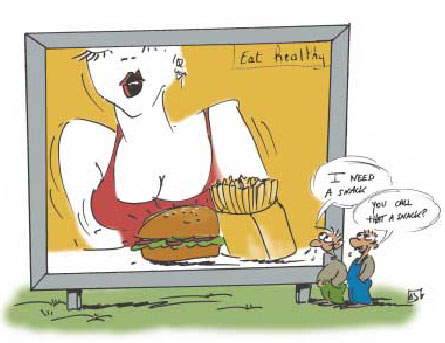
French public health legislation passed in August 2004 stipulates that (our translation) "television or radio advertisements for beverages containing added sugar, salt or artificial sweeteners and for food products processed and sold in France must contain health information" (1,2).
Two-and-a-half years later, on 27 February 2007, a decree defined the nature of this information and conditions for its use (3). It consists of four short messages: "For your health, eat at least five fruits and vegetables a day"; "For your health, exercise regularly"; "For your health, avoid eating too many foods that are high in fat, sugar or salt"; "For your health, avoid snacking between meals".
Barely noticeable messages
On television and in cinemas these health messages are shown on a thin horizontal band (corresponding to only 7% of the height of the screen), or as a screened notice displayed just after the advertisement. On radio, the message is broadcast immediately after the advert. Printed materials include a horizontal message strip also corresponding to 7% of the total height of the advert (3). The speed at which these messages are flashed on screen is not defined in legislation, nor is their colour, typeface or font size. Advertisers who do not want to show these messages can elect instead to pay a tax (1.5% of the cost of the advertisement) to the French national institute for health prevention and education (Inpes) (1).
A French consumer organisation (UFC-Que Choisir) tested the impact of a health message during a TV advert (4). Nearly half of the members of the viewer panel (57% of children and 38% of parents) didn’t even notice the message! If they did read it, 68% of parents and 63% of children who were asked about the link between the health information message and the product being promoted, thought the message endorsed the "healthy" nature of the advertised food (which in fact had a 37% sugar content (4).
Another survey conducted by the same consumer organisation showed that 89% of food adverts aimed at children were for products that had no nutritional value and that were often high in fat and sugar (5); the survey also confirmed the active role that advertising plays in establishing children's food preferences and its influence on families' eating habits (5).
Clear and strict regulation needed
Since 1 April 2007 in the United Kingdom, advertisements for foods excessively high in fat, salt and sugar must not be broadcast during or around the time of programmes intended for 4- to 9-year-olds, including those on children's channels (a)(6). On 1 January 2008 this measure will be extended to programmes aimed at 4-to 15-year-olds. Children's channels have to comply with this measure before 1 January 2009 (6).
According to Claude Got, a French public health specialist: "advertisers will never play an educational role; their role is to seduce, and their skills are for sale to those seeking to bypass consumers' defenses and to stimulate impulse buying" (7).
At a time when the European Parliament is committed to liberalizing TV advertising, with only a semblance of consumer protection under the guise of "codes of good advertising practice", the British example represents the very minimum that is needed of what needs to be done (8). The prevention of obesity requires unequivocal measures to limit, and possibly even to prohibit, advertisements for industrially manufactured food.
©Prescrire 2007
Prescrire Int 2007; 16 (92): 261.
Notes:
a- The UK Food Standards Agency has drawn up a points system for food products based on the number of calories, and amounts of sugar, fat, salt, protein, fiber, fruit and vegetables they contain. When foods are over 4 points and beverages are over 1 point, a product is considered as "high in saturated fat, salt or sugar". Website www.food.gov.uk accessed 29 March 2007: 1 page.
References:
1- "Loi n° 2004-806 du 9 août 2004 relative à la politique de santé publique" Journal Officiel du 11 août 2004: 14277-14336.
2- Prescrire Rédaction "Prévention nutritionnelle: maintenant agissons" Rev Prescrire 2005; 25 (257): 63-64.
3- "Arrêté du 27 février 2007 fixant les conditions relatives aux informations à caractère sanitaire devant accompagner les messages publicitaires ou promotionnels en faveur de certains aliments et boissons" Journal Officiel 28 February 2007: 3 pages.
4- "Obésité et publicités télévisées, quelles mesures de protection pour les enfants ?" Dossier UFC-Que Choisir. Website www.quechoisir.org accessed 29 March 2007: 23 pages.
5- "Les publicités de l’industrie agroalimentaire. Influences sur les préférences et les comportements alimentaires des enfants" Dossier UFC-Que Chosir. Website www.quechoisir.org accessed on 29 March 2007: 24 pages.
6- "Television advertising of food and drink products to children". Website www.ofcom.org.uk accessed 29 March 2007: 5 pages.
7- Got C "Déséquilibre. L’insuffisance de l’attention portée au problème de l’obésité". In: Got C "Comment tuer l’État. Précis de malfaçons et de malfaisances" Bayard, Paris 2005: 41-48. Presented in Rev Prescrire 2006; 26 (268): 70.
8- "MEPs set new rules on TV commercials and product placement". European Parliament press release 13 December 2006: 3 pages.
